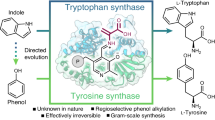Abstract
THE function of viral neuraminidase (N-acetylneuraminate glycohydrolase, EC 3.2.1.18) during the reproductive cycle of myxoviruses is not yet clearly defined. It was therefore considered that potent inhibitors might be utilized to gain further insight into the role of this enzyme. In experiments involving the interaction of myxoviruses with phosphotungstic acid, it has been found that this compound is a potent inhibitor of neuraminidases at extremely low concentrations. A closer examination of this phenomenon revealed that the anionic character of this substance is responsible for the effect. Different polyanions were tested and some of them were found to be even more effective inhibitors of neuraminidase.
This is a preview of subscription content, access via your institution
Access options
Subscribe to this journal
Receive 51 print issues and online access
$199.00 per year
only $3.90 per issue
Buy this article
- Purchase on Springer Link
- Instant access to full article PDF
Prices may be subject to local taxes which are calculated during checkout
Similar content being viewed by others
References
Buddecke, E., and Drzeniek, R., Z. Physiol. Chem., 327, 49 (1962).
Rott, R., Zbl. Vet. Med., B12, 74 (1965).
Aminoff, D., Biochem. J., 81, 384 (1961).
Drzeniek, R., Seto, J. T., and Rott, R., Biochim. Biophys. Acta (in the press).
Dixon, M., Biochem. J., 55, 170 (1953).
Author information
Authors and Affiliations
Rights and permissions
About this article
Cite this article
DRZENIEK, R. Inhibition of Neuraminidase by Polyanions. Nature 211, 1205–1206 (1966). https://doi.org/10.1038/2111205a0
Issue Date:
DOI: https://doi.org/10.1038/2111205a0
This article is cited by
-
Über die Hemmung bakterieller Neuraminidasen durch verschiedene Anionen
Experientia (1975)
-
Substrate specificity of neuraminidases
The Histochemical Journal (1973)
-
Wechselwirkungen zwischen Myxoviren und Zelloberflächen
Zeitschrift für Medizinische Mikrobiologie und Immunologie (1970)
-
Die Aktivität bakterieller, viraler und animalischer Neuraminidasen
Naunyn-Schmiedebergs Archiv für Pharmakologie (1969)
Comments
By submitting a comment you agree to abide by our Terms and Community Guidelines. If you find something abusive or that does not comply with our terms or guidelines please flag it as inappropriate.



